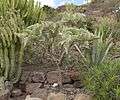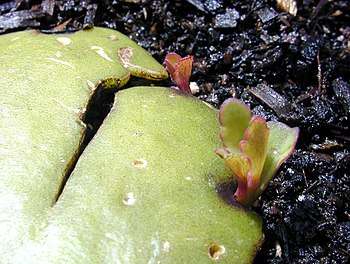Kalanchoe
Kalanchoe /ˌkæləŋˈkoʊ.iː/,[2] or kal-un-KOH-ee,[3] or kal-un-kee, also written Kalanchöe or Kalanchoë, is a genus of about 125 species of tropical, succulent flowering plants in the family Crassulaceae, mainly native to Madagascar and tropical Africa. Kalanchoe was one of the first plants to be sent into space, sent on a resupply to the Soviet Salyut 1 space station in 1971.
| Kalanchoe | |
|---|---|
 | |
| Kalanchoe blossfeldiana | |
| Scientific classification | |
| Kingdom: | Plantae |
| Clade: | Tracheophytes |
| Clade: | Angiosperms |
| Clade: | Eudicots |
| Order: | Saxifragales |
| Family: | Crassulaceae |
| Subfamily: | Kalanchoideae |
| Genus: | Kalanchoe Adans. |
| Subgenera[1] | |
| |
| Synonyms | |
|
Bryophyllum | |
Description
Most are shrubs or perennial herbaceous plants, but a few are annual or biennial. The largest, Kalanchoe beharensis from Madagascar, can reach 6 m (20 ft) tall, but most species are less than 1 m (3 ft) tall.
Kalanchoes are characterized by opening their flowers by growing new cells on the inner surface of the petals to force them outwards, and on the outside of the petals to close them. Kalanchoe flowers are divided into 4 sections with 8 stamens. The petals are fused into a tube, in a similar way to some related genera such as Cotyledon.[4]
 Kalanchoe luciae
Kalanchoe luciae.jpg) Kalanchoe delagoensis
Kalanchoe delagoensis

.jpg)

Taxonomy
The genus was first described by the botanist Michel Adanson in 1763.[5]
Kamel's species was most likely Kalanchoe ceratophylla as he describes the plant as having deeply divided leaves. Kalanchoe ceratophylla and Kalanchoe laciniata are both called 伽蓝菜[6] (apparently "Buddhist monastery [samghārāma] herb") in China. In Mandarin Chinese, it does not seem very close in pronunciation (qiélán cài, but possibly jiālán cài or gālán cài as the character 伽 has multiple pronunciations), but the Cantonese gālàahm choi is closer. The genus Bryophyllum was described by Salisbury in 1806 and the genus Kitchingia was created by Baker in 1881. Kitchingia is now regarded as a synonym for Kalanchoe, while Bryophyllum has also been treated as a separate genus,[5] since species of Bryophyllum appear to be nested within Kalanchoe on molecular phylogenetic analysis, Bryophyllum is considered as a section of the former, dividing the genus into three sections, Kitchingia, Bryophyllum, and Eukalanchoe.[7][8][9] these were formalised as subgenera by Smith and Figueiredo (2018).[1]
Etymology
Adanson cited Georg Joseph Kamel (Camellus) as his source for the name.[10][11] The name came from the Cantonese name "Kalanchauhuy", 伽藍菜.[12]
List of selected species
- Kalanchoe adelae
- Kalanchoe arborescens
- Kalanchoe beauverdii
- Kalanchoe beharensis – Velvet leaf, felt plant, felt bush
- Kalanchoe bentii
- Kalanchoe blossfeldiana – Flaming katy, Christmas kalanchoe, florist kalanchoe, Madagascar widow's-thrill
- Kalanchoe bouvetii
- Kalanchoe bracteata
- Kalanchoe brasiliensis
- Kalanchoe ceratophylla
- Kalanchoe crenata
- Kalanchoe crundallii
- Kalanchoe daigremontiana – Devil's backbone, Mexican-hat plant, mother of thousands
- Kalanchoe dinklagei
- Kalanchoe eriophylla
- Kalanchoe fadeniorum
- Kalanchoe farinacea
- Kalanchoe figuereidoi
- Kalanchoe flammea
- Kalanchoe gastonis-bonnieri – Donkey ears, life plant
- Kalanchoe glaucescens
- Kalanchoe garambiensis
- Kalanchoe gracilipes
- Kalanchoe grandidieri
- Kalanchoe grandiflora
- Kalanchoe hildebrantii – Silver teaspoons
- Kalanchoe humilis
- Kalanchoe jongmansii
- Kalanchoe kewensis
- Kalanchoe laciniata
- kalanchoe laetivirens
- Kalanchoe lateritia
- Kalanchoe laxiflora
- Kalanchoe linearifolia
- Kalanchoe longiflora – Long-flower kalanchoe
- Kalanchoe luciae – Paddle plant
- Kalanchoe macrochlamys
- Kalanchoe marmorata – Penwiper
- Kalanchoe marnieriana
- Kalanchoe millottii
- Kalanchoe miniata
- Kalanchoe nyikae
- Kalanchoe obtusa
- Kalanchoe orgyalis
- Kalanchoe petitiana
- Kalanchoe pinnata (Lam.) Pers.[7]
- Kalanchoe porphyrocalyx
- Kalanchoe prasina
- Kalanchoe pubescens
- Kalanchoe pumila
- Kalanchoe quartiniana
- Kalanchoe rhombopilosa – Pies from heaven
- Kalanchoe robusta
- Kalanchoe rolandi-bonapartei
- Kalanchoe rosei
- Kalanchoe rotundifolia
- Kalanchoe schizophylla
- Kalanchoe serrata
- Kalanchoe sexangularis
- Kalanchoe streptantha
- Kalanchoe suarezensis
- Kalanchoe synsepala – Cup kalanchoe, walking kalanchoe
- Kalanchoe thyrsiflora – Flapjacks, desert cabbage, white lady, geelplakkie, meelplakkie, plakkie
- Kalanchoe tomentosa – Panda plant
- Kalanchoe tubiflora – Chandelier plant, mother of millions, mother of thousands
- Kalanchoe uniflora
- Kalanchoe producta
- Kalanchoe viguieri
Distribution and ecology
The genus is predominantly native to the Old World. Only one species of this genus originates from the Americas, 56 from southern and eastern Africa and 60 species in Madagascar. It is also found in south-eastern Asia and China.[13]
These plants are the food plant of the caterpillars of Red Pierrot butterfly. The butterfly lays its eggs on phylloclades, and after hatching, caterpillars burrow into phylloclades and eat their inside cells.
Cultivation and uses

These plants are cultivated as ornamental houseplants and rock or succulent garden plants. They are popular because of their ease of propagation, low water requirements, and wide variety of flower colors typically borne in clusters well above the phylloclades. The section Bryophyllum—formerly an independent genus—contains species such as the "air-plant" Kalanchoe pinnata. In these plants, new individuals develop vegetatively as plantlets, also known as bulbils or gemmae, at indentations in phylloclade margins. These young plants eventually drop off and take root. No males have been found of one species of this genus which does flower and produce seeds, and it is commonly called the mother of thousands: Kalanchoe daigremontiana is thus an example of asexual reproduction.[14]
The cultivars ‘Tessa’[15] and ‘Wendy’ have gained the Royal Horticultural Society’s Award of Garden Merit.[16][17]
Diseases
Toxicity and traditional medicine
In common with other Crassulaceae (such as the genera Tylecodon, Cotyledon and Adromischus), some Kalanchoe species contain bufadienolide cardiac glycosides[18] which can cause cardiac poisoning, particularly in grazing animals.[19][20] This is a particular problem in the native range of many Kalanchoe species in the Karoo region of South Africa, where the resulting animal disease is known as krimpsiekte (shrinking disease) or as cotyledonosis.[21] Similar poisonings have also occurred in Australia.
In traditional medicine, Kalanchoe species have been used to treat ailments such as infections, rheumatism and inflammation. Kalanchoe extracts also have immunosuppressive effects. Kalanchoe pinnata has been recorded in Trinidad and Tobago as being used as a traditional treatment for hypertension.[22]
A variety of bufadienolide compounds have been isolated from various Kalanchoe species. Five different bufadienolides have been isolated from Kalanchoe daigremontiana.[23][24] Two of these, daigremontianin and bersaldegenin 1,3,5-orthoacetate, have been shown to have a pronounced sedative effect. They also have the strong positive inotropic effect associated with cardiac glycosides, and with greater doses an increasing effect on the central nervous system.
Bufadienolide compounds isolated from Kalanchoe pinnata include bryophillin A which showed strong anti-tumor promoting activity, and bersaldegenin-3-acetate and bryophillin C which were less active.[25] Bryophillin C also showed insecticidal properties.[26]
References
- Smith & Figueiredo 2018.
- Sunset Western Garden Book, 1995:606–607; "Kalanchoe". Oxford English Dictionary (3rd ed.). Oxford University Press. September 2005. (Subscription or UK public library membership required.)
- http://gardening.about.com/od/houseplants/tp/FloweringHouseplants.htm
- Crassulaceae Network
- Baldwin Jr., J. T. (October 1938). "Kalanchoe: The Genus and its Chromosomes". American Journal of Botany. 25 (8): 572–579. doi:10.2307/2436516. JSTOR 2436516.
- Kalanchoe, Chinese Plant Names, www.eFloras.org.
- POTWO 2019.
- Mort et al 2009.
- Eggli 2003.
- Adanson, M. (1763) Familles des plantes 2: 530
- Camel, J.G. Herbarum aliarumque stirpium in Insulâ Luzone Philippinarum Primariâ Nascentium In: Ray, J. (1704): Historia plantarum Book 3, Appendix p.6, item 18
- Chernetskyy, M. A. (2011). "Problems in nomenclature and systematics in the subfamily Kalanchoideae (Crassulaceae) over the years". Acta Agrobotanica. 6 (4): 67–74.
- ird.fr: Allorge-Boiteau, L., 1996. Madagascar Centre de Spéciation et d'Origine du Genre Kalanchoe (Crassulaceae). Biogéographie de Madagascar, 1996 : 137-145
- Reproductive Strategies: Plants. (1999). In Encyclopedia of Paleontology. Retrieved from http://www.credoreference.com/entry/routpaleont/reproductive_strategies_plants .
- "RHS Plantfinder - Kalanchoe 'Tessa'". Retrieved 14 March 2018.
- "RHS Plantfinder - Kalanchoe 'Wendy'". Retrieved 14 March 2018.
- "AGM Plants - Ornamental" (PDF). Royal Horticultural Society. July 2017. p. 56. Retrieved 14 March 2018.
- Steyn, Pieter S; van Heerden, Fanie R. (1998). "Bufadienolides of plant and animal origin". Natural Product Reports. Royal Society of Chemistry. Retrieved 2007-09-19.
- McKenzie, RA; Dunster PJ. (July 1986). "Hearts and flowers: Bryophyllum poisoning of cattle". Australian Veterinary Journal. 63 (7): 222–7. doi:10.1111/j.1751-0813.1986.tb03000.x. PMID 3778371.
- McKenzie, RA; Franke FP; Dunster PJ. (October 1987). "The toxicity to cattle and bufadienolide content of six Bryophyllum species". Australian Veterinary Journal. 64 (10): 298–301. doi:10.1111/j.1751-0813.1987.tb07330.x. PMID 3439945.
- Hilton-Taylor, Craig. "How Dangerous are Euphorbias? (And Others in the Family Euphorbiaceae) with some comments on dangerous plants in the families Agavaceae, Aizoaceae, Apocynaceae, Compositae, Crassulaceae, Liliaceae". Archived from the original on 2007-10-01. Retrieved 2007-09-19.
- Lans, CA (2006-10-13). "Ethnomedicines used in Trinidad and Tobago for urinary problems and diabetes mellitus". Journal of Ethnobiology and Ethnomedicine. 2: 45. doi:10.1186/1746-4269-2-45. PMC 1624823. PMID 17040567.
- Wagner, H; Fischer M; Lotter H (April 1985). "Isolation and Structure Determination of Daigremontianin, a Novel Bufadienolide from Kalanchoe daigremontiana". Planta Medica. 51 (2): 169–70. doi:10.1055/s-2007-969441. PMID 3839925.
- Supratman, U; Fujita T; Akiyama K; Hayashi H (September 2001). "Insecticidal compounds from Kalanchoe daigremontiana x tubiflora". Phytochemistry. 58 (2): 311–4. doi:10.1016/S0031-9422(01)00199-6. PMID 11551556.
- Supratman, U; Fujita T; Akiyama K; Hayashi H; Murakami A; Sakai H; Koshimizu K; Ohigashi H (April 2001). "Anti-tumor promoting activity of bufadienolides from Kalanchoe pinnata and K. daigremontiana x tubiflora". Bioscience, Biotechnology, and Biochemistry. 65 (4): 947–9. doi:10.1271/bbb.65.947. PMID 11388478.
- Supratman, U; Fujita T; Akiyama K; Hayashi H (June 2000). "New insecticidal bufadienolide, bryophyllin C, from Kalanchoe pinnata". Bioscience, Biotechnology, and Biochemistry. 64 (6): 1310–2. doi:10.1271/bbb.64.1310. PMID 10923811.
Bibliography
- Eggli, Urs, ed. (2003). Illustrated Handbook of Succulent Plants: Crassulaceae. Springer Science & Business Media. doi:10.1007/978-3-642-55874-0. ISBN 978-3-642-55874-0.CS1 maint: ref=harv (link)
- Smith, Gideon F.; Figueiredo, Estrela; Wyk, Abraham E. van (2019). Kalanchoe (Crassulaceae) in Southern Africa: Classification, Biology, and Cultivation. Elsevier Science. ISBN 978-0-12-814008-6.
- Mort, Mark E.; Soltis, Douglas E.; Soltis, Pamela S.; Francisco-Ortega, Javier; Santos-Guerra, Arnoldo (January 2001). "Phylogenetic relationships and evolution of Crassulaceae inferred from matK sequence data". American Journal of Botany. 88 (1): 76–91. doi:10.2307/2657129. JSTOR 2657129.
- Mort, Mark E; O'Leary, T. Ryan; Carrillo-Reyes, Pablo; et al. (December 2009). "Phylogeny and evolution of Crassulaceae: Past, present, and future". Biodiversity & Ecology. 3: 69–86.
- Smith, Gideon F.; Figueiredo, Estrela (July 2018). "The infrageneric classification and nomenclature of Adans. (Crassulaceae), with special reference to the southern African species". Bradleya. 36 (36): 162–172. doi:10.25223/brad.n36.2018.a10.CS1 maint: ref=harv (link)
- "Kalanchoe Adans". Plants of the World Online. Royal Botanic Gardens, Kew. 2019. Retrieved 1 September 2019.